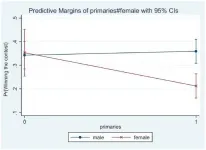(Press-News.org) BINGHAMTON, NY -- Neandertals -- the closest ancestor to modern humans -- possessed the ability to perceive and produce human speech, according to a new study published by an international multidisciplinary team of researchers including Binghamton University anthropology professor Rolf Quam and graduate student Alex Velez.
"This is one of the most important studies I have been involved in during my career", says Quam. "The results are solid and clearly show the Neandertals had the capacity to perceive and produce human speech. This is one of the very few current, ongoing research lines relying on fossil evidence to study the evolution of language, a notoriously tricky subject in anthropology."
The evolution of language, and the linguistic capacities in Neandertals in particular, is a long-standing question in human evolution.
"For decades, one of the central questions in human evolutionary studies has been whether the human form of communication, spoken language, was also present in any other species of human ancestor, especially the Neandertals," says coauthor Juan Luis Arsuaga, Professor of Paleontology at the Universidad Complutense de Madrid and co-director of the excavations and research at the Atapuerca sites. The latest study has reconstructed how Neandertals heard to draw some inferences about how they may have communicated.
The study relied on high resolution CT scans to create virtual 3D models of the ear structures in Homo sapiens and Neandertals as well as earlier fossils from the site of Atapuerca that represent ancestors of the Neandertals. Data collected on the 3D models were entered into a software-based model, developed in the field of auditory bioengineering, to estimate the hearing abilities up to 5 kHz, which encompasses most of the frequency range of modern human speech sounds. Compared with the Atapuerca fossils, the Neandertals showed slightly better hearing between 4-5 kHz, resembling modern humans more closely.
In addition, the researchers were able to calculate the frequency range of maximum sensitivity, technically known as the occupied bandwidth, in each species. The occupied bandwidth is related to the communication system, such that a wider bandwidth allows for a larger number of easily distinguishable acoustic signals to be used in the oral communication of a species. This, in turn, improves the efficiency of communication, the ability to deliver a clear message in the shortest amount of time. The Neandertals show a wider bandwidth compared with their ancestors from Atapuerca, more closely resembling modern humans in this feature.
"This really is the key," says Mercedes Conde-Valverde, professor at the Universidad de Alcalá in Spain and lead author of the study. "The presence of similar hearing abilities, particularly the bandwidth, demonstrates that the Neandertals possessed a communication system that was as complex and efficient as modern human speech."
"One of the other interesting results from the study was the suggestion that Neandertal speech likely included an increased use of consonants," said Quam. "Most previous studies of Neandertal speech capacities focused on their ability to produce the main vowels in English spoken language. However, we feel this emphasis is misplaced, since the use of consonants is a way to include more information in the vocal signal and it also separates human speech and language from the communication patterns in nearly all other primates. The fact that our study picked up on this is a really interesting aspect of the research and is a novel suggestion regarding the linguistic capacities in our fossil ancestors."
Thus, Neandertals had a similar capacity to us to produce the sounds of human speech, and their ear was "tuned" to perceive these frequencies. This change in the auditory capacities in Neandertals, compared with their ancestors from Atapuerca, parallels archaeological evidence for increasingly complex behavioral patterns, including changes in stone tool technology, domestication of fire and possible symbolic practices. Thus, the study provides strong evidence in favor of the coevolution of increasingly complex behaviors and increasing efficiency in vocal communication throughout the course of human evolution.
The team behind the new study has been developing this research line for nearly two decades, and has ongoing collaborations to extend the analyses to additional fossil species. For the moment, however, the new results are exciting.
"These results are particularly gratifying," said Ignacio Martinez from Universidad de Alcalá in Spain. "We believe, after more than a century of research into this question, that we have provided a conclusive answer to the question of Neandertal speech capacities."
INFORMATION:
The study, "Neandertals and modern humans had similar auditory and speech capacities," was published in Nature Ecology and Evolution.
More than 20 million people 65 years and older present to emergency departments each year in the United States. Roughly one third of those patients are admitted to the hospital often because they cannot be safely discharged to their home. For an older patient, hospitalization comes with the increased risk of infection, falls, delirium, functional decline and death. Hospitalizations also come with increased cost to the patient, provider and payer. According to the Centers for Medicare & Medicaid Services (CMS), the average cost of an inpatient hospital stay is more than $13,800 per Medicare beneficiary.
As the U.S. population ages, more hospitals are implementing geriatric emergency ...
As the planet warms, scientists expect that mountain snowpack should melt progressively earlier in the year. However, observations in the U.S. show that as temperatures have risen, snowpack melt is relatively unaffected in some regions while others can experience snowpack melt a month earlier in the year.
This discrepancy in the timing of snowpack disappearance--the date in the spring when all the winter snow has melted--is the focus of new research by scientists at Scripps Institution of Oceanography at the University of California San Diego.
In a new study published March 1 in the journal Nature Climate ...
For the first time, scientists have assessed how many corals there are in the Pacific Ocean--and evaluated their risk of extinction.
While the answer to "how many coral species are there?" is 'Googleable', until now scientists didn't know how many individual coral colonies there are in the world.
"In the Pacific, we estimate there are roughly half a trillion corals," said the study lead author, Dr Andy Dietzel from the ARC Centre of Excellence for Coral Reef Studies at James Cook University (Coral CoE at JCU).
"This is about the same number of trees in the Amazon, or ...
UNIVERSITY OF CALIFORNIA, SAN FRANCISCO
UNIVERSITY OF TORONTO
Toronto, ON - Children in the United States who have more screen time at ages 9-10 are more likely to develop binge-eating disorder one year later, according to a new national study.
The study, published in the International Journal of Eating Disorders on March 1, found that each additional hour spent on social media was associated with a 62% higher risk of binge-eating disorder one year later. It also found that each additional hour spent watching or streaming television or movies led to a 39% ...
HANOVER, N.H. - March 1, 2020 - During World War II, British intelligence agents planted false documents on a corpse to fool Nazi Germany into preparing for an assault on Greece. "Operation Mincemeat" was a success, and covered the actual Allied invasion of Sicily.
The "canary trap" technique in espionage spreads multiple versions of false documents to conceal a secret. Canary traps can be used to sniff out information leaks, or as in WWII, to create distractions that hide valuable information.
WE-FORGE, a new data protection system designed at Dartmouth's Department ...
Assessing a drug compound by its activity, not simply its structure, is a new approach that could speed the search for COVID-19 therapies and reveal more potential therapies for other diseases.
This action-based focus -- called biological activity-based modeling (BABM) -- forms the core of a new approach developed by National Center for Advancing Translational Sciences (NCATS) researchers and others. NCATS is part of the National Institutes of Health (NIH). Researchers used BABM to look for potential anti-SARS-CoV-2 agents whose actions, not their structures, are similar to those of compounds already shown to be effective.
NCATS scientists ...
The hidden social, environmental and health costs of the world's energy and transport sectors is equal to more than a quarter of the globe's entire economic output, new research from the University of Sussex Business School and Hanyang University reveals.
According to analysis carried out by Professor Benjamin K. Sovacool and Professor Jinsoo Kim, the combined externalities for the energy and transport sectors worldwide is an estimated average of $24.662 trillion - the equivalent to 28.7% of global Gross Domestic Product.
The study found that the true cost of coal should be more than twice as high as current prices when factoring in the currently unaccounted ...
A study by two researchers at the UPF Department of Political and Social Sciences (DCPIS) has examined the effect of selecting party leaders by direct vote by the entire membership (a process known in southern Europe as "primaries" and in English-speaking countries as "one-member-one -vote", OMOV) on the likelihood of a woman winning a leadership competition against male rivals.
Javier Astudillo and Andreu Paneque, a tenured lecturer and PhD with the DCPIS, respectively, and members of the Institutions and Political Actors Research Group, are the authors of the article published recently in the journal ...
TROY, N.Y. -- The era of widespread remote learning brought about by the COVID-19 pandemic requires online testing methods that effectively prevent cheating, especially in the form of collusion among students. With concerns about cheating on the rise across the country, a solution that also maintains student privacy is particularly valuable.
In research published today in npj Science of Learning, engineers from Rensselaer Polytechnic Institute demonstrate how a testing strategy they call "distanced online testing" can effectively reduce students' ability to receive help from one another in order to score higher on a test taken at individual homes during social distancing.
"Often in remote online exams, students ...
A group of researchers including Tiago Falótico, a Brazilian primatologist at the University of São Paulo's School of Arts, Sciences and Humanities (EACH-USP), archeologists at Spain's Catalan Institute of Human Paleoecology and Social Evolution (IPHES) and University College London in the UK, and an anthropologist at the Max Planck Institute for Evolutionary Anthropology in Germany, have published an article in the Journal of Archeological Science: Reports describing an analysis of stone tools used by bearded capuchin monkeys (Sapajus libidinosus) that inhabit ...





